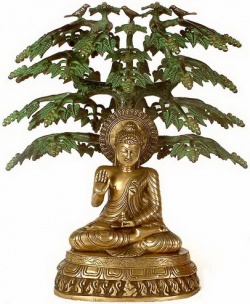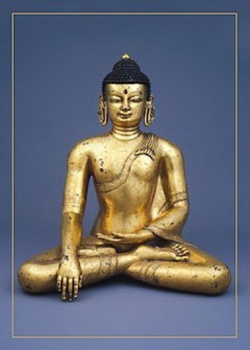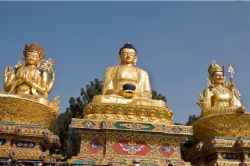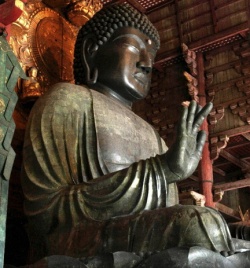Bodhi
- See also: Enlightenment
Bodhi (Sanskrit: बोधि; and Pali) 菩提 (Skt, Pali; Jpn bodai) in Buddhism is the understanding possessed by a Buddha regarding the nature of things. It is traditionally translated into English with the word Enlightenment and literally means Awakened.
Bodhi is Knowledge into the causal mechanism by which beings incarnate into material Form and experience Suffering. Although its most common usage is in the context of Buddhism, bodhi is also present as a concept in other Indian philosophies and traditions. bodhi is a Pali or Sanskrit word which means "awakened."
It means the state the Buddha reached as he sat under the bodhi tree (Sacred Fig or Ficus religiosa) at Bodhgaya and realized His "original nature," thus this state was given the name "bodhi."
See; "Adharma Buddha," "enlightenment."
Etymology
Bodhi is an abstract noun formed from the verbal root budh (to awake, become aware, notice, know or understand) corresponding to the verbs bujjhati (Pāli) and bodhati or budhyate (Sanskrit). Also from the same root are the Sanskrit words bodha (also meaning Knowledge or intelligence) and buddhi which is the exact equivalent to the Greek word nous.
Soteriological meaning
The soteriological goal of Indian religions is Liberation or moksha (also called mukti). Liberation is simultaneously freedom from Suffering and the endless round of existences.
Within the Sramanic traditions one who has attained Liberation is called an Arhat (Sanskrit; Pali: Arahant), an honorific term meaning 'worthy' acknowledging the skill and effort required to overcome the obstacles to the goal of Nirvana.
According to The Buddha the Path to Liberation is one of progressively coming out of Delusion (Pali: Moha). This Path is therefore regarded as a Path of Awakening. Progressing along the Path towards Nirvana one gains Insight into the true nature of things.
A Buddha is one who has attained Liberation and an understanding of the causal mechanism by means of which Sentient beings come into existence. This mechanism is called pratitya samutpada or Dependent origination. The Knowledge or understanding of this is called bodhi.
Buddha's Awakening
In the suttapitaka, the Buddhist Canon as preserved in the Theravada-tradition, a number of texts can be found in which The Buddha tells about his own Awakening.
In the Vanapattha Sutta (Majjhima, chapter 17) The Buddha describes Life in the jungle, and the attainment of Awakening. After destroying the disturbances of the Mind, and the Concentration of the Mind, he attained three knowledges (vidhya):
- Insight into his past lives
- Insight into the workings of Karma and Reincarnation
- Insight into The Four Noble Truths
Insight into The Four Noble Truths is here called Awakening. The Monk (Bhikkhu) has
Awakening is also described as synonymous with Nirvana, the extinction of the passions whereby Suffering is ended and no more rebirths take place. The Insight arises that this Liberation is certain:
- Knowledge arose in me, and Insight: my freedom is certain, this is my last birth, now there is no Rebirth".
So Awakening is Insight into Karma and Rebirth, Insight into The Four Noble Truths, the extinction of the passions whereby Nirvana is reached, ànd the certainty thàt Liberation has been reached.
The Buddhist Path
- See also: Buddhist Paths to Liberation
The Buddhist tradition gives a wide variety of descriptions of the Buddhist Path (Magga) to Liberation. Tradition describes The Buddha's Awakening, and the descriptions of the Path given in the Sutta Pitaka.
By following this Path Buddhahood can be attained. Following this Path dissolves the ten Fetters and terminates volitional actions that bind a human being to the Wheel of Samsara.
The Theravada-tradition follows the Path to Purification described by Buddhaghosa in his Visuddhimagga. It features four progressive stages culminating in full Enlightenment. The four stages are Sotapanna, Sakadagami, Anagami and Arahat.
Three Types of Buddha are recognized:
Arhat (Pali: Arahant), those who reach Nirvana by following the teachings of The Buddha. Sometimes the term Śrāvakabuddha (Pali: Sāvakabuddha) is used to designate this kind of Awakened person;
- Pratyekabuddhas (Pali: Paccekabuddha), those who reach Nirvana through self-realisation, without the aid of Spiritual guides and teachers, but don't teach the Dharma;
- Samyaksambuddha (Pali: samma sambuddha), often simply referred to as Buddha, one who has reached Nirvana by his own efforts and Wisdom and teach it skillfully to others.
Development of the concept
The term bodhi acquired a variety of meanings and connotations during the development of Buddhist thoughts in the various schools.
Early Buddhism
In early Buddhism, bodhi carried a meaning synonymous to Nirvana, using only some different metaphors to describe the Insight, which implied the extinction of Lobha (Greed), dosa (hate) and Moha (Delusion). In Theravada Buddhism, bodhi and Nirvana carry the same meaning, that of being freed from Greed, hate and Delusion.
Mahayana
In Mahayana-Thought, bodhi is the realisation of the inseparability of Samsara and Nirvana, and the unity of subject and object.
It is similar to Prajna, to realizing the Buddha-nature, realizing Sunyata and realizing suchness.
Mahayana discerns three forms of bodhi:
- Arahat - Liberation for oneself;
- Bodhisattva - Liberation for living beings;
- Full Buddhahood.
Within the various Mahayana-schools exist various further explanations and interpretations.
Buddha-nature
In the Tathagatagarbha and Buddha-nature doctrines bodhi becomes equivalent to the universal, natural and pure state of the Mind:
- Bodhi is the final goal of a Bodhisattva's career [...] Bodhi is pure universal and immediate Knowledge, which extends over all time, all universes, all beings and elements, conditioned and unconditioned.
It is absolute and identical with Reality and thus it is Tathata. Bodhi is immaculate and non-conceptual, and it, being not an outer object, cannot be understood by discursive Thought. It has neither beginning, nor middle nor end and it is indivisible. It is non-dual (advayam) [...] The only possible way to comprehend it is through Samadhi by the yogin.
According to these doctrines bodhi is always there within one's Mind, but requires the Defilements to be removed. This vision is expounded in texts such as The Shurangama Sutra and the Uttaratantra.
In Shingon Buddhism, the state of Bodhi is also seen as naturally inherent in the Mind. It is the Mind's natural and pure state, where no distinction is being made between a perceiving subject and perceived objects.
This is also the understanding of Bodhi found in Yogacara Buddhism and the Mind's natural and pure state as in Dzogchen.
To achieve this vision of Non-duality, it is necessary to recognise one's own Mind:
- ... it means that you are to know the inherent natural state of the Mind by eliminating the split into a perceiving subject and perceived objects which normally occurs in the World and is wrongly Thought to be real. This also corresponds to the Yogacara definition ... that Emptiness (Sunyata) is the absence of this imaginary split
Harmonisation of the various terms and meanings
During the development of Mahayana Buddhism the various strands of Thought on Bodhi were continuously being elaborated. Attempts were made to harmonize the various terms. The Buddhist commentator Buddhaguhya treats various terms as synonyms:
- For example, he defines Emptiness (Sunyata) as suchness (Tathata) and says that suchness is the intrinsic nature (Svabhava) of the Mind which is Enlightenment (bodhicitta).
Moreover, he frequently uses the terms suchness (Tathata) and Suchness-Awareness (Tathata-jnana) interchangeably.
But since Awareness (jnana) is non-dual, Suchness-Awareness is not so much the Awareness of Suchness, but the Awareness which is Suchness. In other words, the term Suchness-Awareness is functionally equivalent to Enlightenment.
Finally, it must not be forgotten that this Suchness-Awareness or Perfect Enlightenment is Mahavairocana the Primal Buddha, uncreated and forever existent). In other words, the Mind in its intrinsic nature is Mahavairocana, whom one "becomes" (or vice-versa) when one is perfectly Enlightened.




